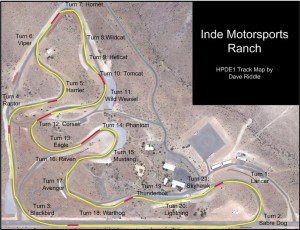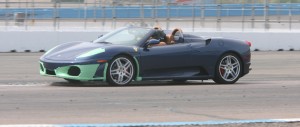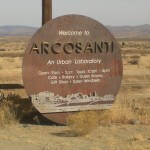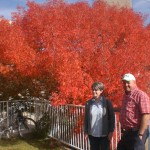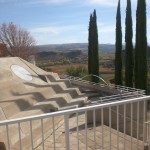Racing/Cars
Teaching with Team Safety
Besides teaching the HPDE1 class for the National Auto Sport Association (NASA) one of the most enjoyable things I do is volunteer with Team Safety Driving School. Here is a little bit of a write up I did for another parent that was considering sending their kid through the course.
Note a typical day will see the Students start driving at about 8:00am and will drive all day until about 4:00p.
The course starts out with them driving slowly through a slalom course and gradually picking up speed. This mimics them changing lanes with the higher speed runs to make them confident they can do so in an emergency situation on the Freeway if they had to serve to avoid something.
Then we move into braking exercises. They accelerate up to around 45-50 mph and then use 100% braking (without locking up or getting into ABS) to bring the car to a stop without hitting some cones. This is followed by having them use 50% of the traction of the tires to slow down while using the other 50% of the traction avoiding an obstacle (cone) placed in front of them. Then we have them use greater than 100% braking ability by engaging the ABS under braking while maneuvering around the obstacle.
At the start and conclusion of their runs on course we have a “box” of cones setup that they bring the vehicle to a stop in and they need to stop centered in that box to get them comfortable with the size and shape of their vehicle.
At the end of the day we have the parents get in the car with their child to go for a ride along as they perform the maneuvers they learned that day. Parents can either drop off their child (with the vehicle they will be driving) or they can stay and observe. We have chairs to sit on and canopies to sit under. Plenty of water and lunch is provided”
and
Here is a video I shot with one of the students on her first run through the course after we introduced the 100% braking portions. We drive them through the course 1-2 times to show them what we want them to work on then move to the passenger seat for 1-2 runs as they drive. Once we are sure they understand and are able to perform the task we get out of the car to let them practice independently. When they reach the stop box at the end of the run we will offer some constructive critiques and then send them back out.
httpv://youtu.be/KH3UDCW90j0
[media id=63 width=320 height=240]
Paul Lynch – NASA National TTU
Video of the TT session at NASA Nationals at Miller. Paul Lynch leading in TTU
[media id=62 width=320 height=240]
Vintage Car Crashes at the 2005 BRIC at Road America
Multiple camera angles: From the stands and on-board most of the cars involved in the incident. Unbelievable how many cars were destroyed before even reaching the starting line.
[media id=50 width=320 height=240]
At the beginning of the Group 6 race in the 2005 Brian Redman International Challenge (now the Kohler International Challenge), there was a large incident consisting of most of the field: The driver starting fifth accelerated well before the green flag and tried to force his way between the wall and the car in front of him, resulting in contact with the wall. A following car checked up and was rear-ended, causing a spin that led to further contact as following cars were unable to avoid the growing incident. After just a few seconds of green flag racing, the red flag was waved. Following the initial incident, the failure of trailing drivers to heed red flags being shown at 14 and 15 (under the bridge at the crest of the hill) may have compounded the issue. Luckily, nobody was seriously injured, with the worst injury being a broken arm
Inde Motorsports Ranch
A lap around AMP
In anticipation of Arizona Motorsports Park reopening this coming year for events I shot this video to use in the HPDE1 class I teach for NASA.
The lap was not done at “full” speed as the purpose is to show the line around the track to new strudents.
Enjoy…
[media id=32 width=320 height=240]
Old Video of my F500
Posted this old video from 2000 of my 1983 Red Devil. It’s runs in the SCCA F5 (Formula 500) Open Wheel class.
Fun fast little cars. They can be a real handful to drive quickly Powered by a half-liter 2-Stroke snowmobile engine. The clutches are set so that they do not even engage until 5,000 rpm. Just to move the car is a hole shot. Redline is about 8,600 rpm so they have a very narrow power-band. Coming into a tight corner is a real dance with your left foot stabbing the brakes while your right foot keeps blipping the throttle to keep the RPM up in that power band to stay on the pipe.
[media id=30 width=320 height=240]
This chassis is no longer competitive in SCCA Competition (have to drive the wheels off it just to keep on the tail end of the modern cars.
Took first place in the Arizona Region Championship in 2001-2002 with the car and even took second place in the Southern Pacific Division National Championship with it.
Then I took a turn in a modern chassis car (KBS Mk5) Wow what an eye opener. Where I had to hustle my car through turns I was able to drift that KBS right at the edge of adhesion at will without breaking a sweat. Time to move this basically unmolested car into one of the vintage organizations. Can’t be too many of the cars of this vintage still running in the condition that this car is in.
Oh, in the video I am the only car on track. Yeah, it’s that loud. I have a friend that lives about 100 yards away from me and if I fire the car up and run it down the street – away from his house) he can hear it. I don’t do that to often. Don’t need John Law dropping by for a visit.
Sound of a Sick Kart
So after a one year and two month layoff from kart racing my son decided he want to stat running again.  He started racing when he was 9 and at 16 decided he wanted to take a break. After running for 7 ytears I think most of us would want to take a break.
Well just prior to calling a halt last year had purchased a new pump around setup (converted carb and dual fuel pump setup) to replace our stock carb using a TrackMagic “MagicCan” setup. We figured this was part of the problem we had at Sandia last year.
Installed the new carb setup, checked the kart over, replaced the brake pads, bled the system put fuel in it and headed to the track.
First session lasted two laps until he brought the kart in complaining that 1st and 2nd gear were fine but that the kart fell on it’s face when shifting to 3rd.
Checked the fuel system and determined that the issue had to be a problem with venting and that the new dual pump setup was over pressurinzing the system. Added a bigger vent tube and overflow catch tank for it.
Back out for the second practice session. Same problem. Back to the pits to work on the issue some more.
This time we addd more wire ties as we thought maybe we were sucking air into the system. Checked jetting and while we were a bit “fat” I did not want to add a “lean burn” to our issues since the day was looking like it was going to be a test session rather than an actual race.
Also did not bother with adjusting gear ratios!
Back out for the third session. Seemed a bit better except the muffler came loose from the pipe and rather then keep running an cause damage he brought it in to the pits for me to look at. Fixed the muffler and sent him back out to finish the session.
Back in the pits I checked the plug for color and it was very wet.
Pulled the carb. Lowered the needle, changed the pilot jet, kept the main jet, replaced the throttle cable and adjusted the pipe bracket (which had caused the pipe to seperate from the muffler).
Lined up dead last on the grid for the race. We had NEVER been in that position before.
At the drop of the Green Flag we we NOT left for dead. The wholesale changes had transformed the kart. Tyler was able to work his up the grid a bit and finished in 10th place in the 125cc Shifter class. A long way down the grid from what were are used to but at least the weekend was salvaged and hopefully we will be back up the grid at the next race in 4 weeks.
The camera on the kart was pointed too low but here is a few laps early in the day when we were fighting the probem. You can see Tyler raise his hands in frustration and signal that he is going slow.
[media id=23 width=320 height=240]
Viper Crash at PIR
Back in 2002 I was the in-car instructor for a student in a Dodge Viper. I had a copy of the incident report on my old site along with a video of the incident. Over the years copies of this video have sprung up on websites all over the place.
Here is a better copy of that video along with the official report I files (with names redacted).
[media id=21 width=320 height=240]
Oh, that morning one of the other instructors had a camera crew up on the roof of the Buddy Jobe suites at the end of the front straight testing out a new HD Camera. That’s why the video is in “wide-screen”
Text of the Report that I filed about the incident (names removed)
Analysis of On-Track Incident at Phoenix International Raceway €“ November 30, 2002
Student: Xxxxx Xxxxxxxx
Scottsdale, AZ
Vehicle: 2000 Dodge Viper Roadster
The morning began with an on-track “station-wagon” session. During this low speed introductory event I took Mr. Xxxxxxxx out for a ride in my 1988 Porsche 944 to show him the line that would be presented to him in the classroom and to show him some of the points of interest that he should pay particular attention to. In particular I showed him the areas that I always stress during these ride-along sessions:
- The need to late apex T2
- The importance of treating T7 as a constant radius, even though the track looks like it is moving out and in on you, so that T8 is a non-event.
- The Proper line through NASCAR 3 and 4 so as to not run the risk of getting to high on the track where there are €œmarbles€ and to not get to low so as to stay above the yellow and white line on the exit of T4. During one of the laps I actually took him below the white line so that he could feel the transition and explained what to do if he were to find himself in that area.
- Told him that every student drives through the Oval the first couple of times at around 60 miles an hour which in turn helps to keep them below our established speed limit.
- Showed him that he is to carry his speed through T1 and use the NASCAR pit boxes between T1 and T2 as his breaking and downshifting area.
When the students were released from their first classroom session I was waiting outside and seeing Mr. Xxxxxxxx I asked him if he had an instructor to ride with him yet. He did not, so I climbed into his car and directed him to drive up to the grid in the cold pits to wait for his session to begin.
While sitting in his car waiting to be released to go on track I asked him some questions about his car and how long he had owned it. He indicated that this was his second Viper and that he had not done any schools before but that he had driven on PIR during a ride around session during a Grand-Am event.
As I normally do I reiterated to him that this was not a race session and that we would not be allowed to pass on the corners, just on the designated straights and that there was an established speed limit on the front straight of no more than 100 miles per hour. I told him the saying that I tell every student and prospective student, “you drove the car out here and you want to drive it home”, therefore, “only drive the car to the level that you feel comfortable doing ” don’t push it.
With that said we eventually headed out onto the track. The first four or five laps were uneventful and I found myself quite impressed that by the second lap he appeared to have mastered the concept of T7, albeit at a fairly low speed but on the line nonetheless. He was driving correctly through the pit boxes between T1 and T2 even though some of the cars in front of us were off this line. His entrance to T2 was not quite late enough but was starting to get better with each lap as he saw the benefit to turning in later each time as I explained to him upon exiting T3.
Eventually we found ourselves with only one car, a BMW Z3, in front of us as we exited T9 onto the Oval and Mr. Xxxxxxxx stayed low on the exit and the Z3 stayed high to wave us by when we passed. This would be his first trip down the front straight were he was not following another student or Novice Street Session driver. He transited through the Oval at almost 70 miles per hour with a comfortable line and speed that did not present any noticeable feelings on the senses. Once onto the front straight he opened up the throttle a bit but maintained the established speed limit. In fact he indicated later, although I did not actually feel it, that he brushed the brakes once to stay under this limit.
On turn-in for T1 he put in the clutch and I believe went down from fourth to third and then second and let out the clutch before I could say anything. As soon as he let the clutch back out the rear end locked up and around the car came. I then found us sliding passenger side first toward the wall and the T1 worker area. At first I thought we were going to miss the wall and if Mr. Xxxxxxxx had moved the wheel slightly with the direction of the spin to bring the nose back around rather than into the spin try and stop it we would have. As it were we hit with a glancing blow and came to a rest a short distance away and on the gore area between the transition of NASCAR 1 and the Road course T1 facing toward the rest of the cars coming through T1 and looking out through the now raised hood of the vehicle.
I restrained Mr. Xxxxxxxx from exiting the vehicle until the corner workers had secured the area with yellow flags (which were out and waving immediately) and that the emergency crew had arrived to act as a roadblock for us with the wrecker. Once they arrived and parked in front of us I allowed Mr. Xxxxxxxx to exit the vehicle.
While waiting in the vehicle for the above to occur I gave the corner workers a €œthumbs-up€ to indicate that we appeared to be ok and uninjured and started the debrief with Mr. Xxxxxxxx when he asked “what did I do wrong?” I told him that the incident was caused due to his downshifting as he entered T1. He indicated to me that “no one” had told him not to do that. I did not argue with him as that was not the time or place given his current state of mind and agitation but I know that I mentioned it during the station wagon session as this is part of my normal delivery during those sessions and I know that this is a topic of one of the slides during the PowerPoint presentation in the first classroom session.
Once out of the vehicle we were checked over by the Ambulance Crew and Mr. Xxxxxxxx was actually transported back to the infield while they took his vitals and filed out there evaluation sheet on him. I stayed out to walk Ralph Evans and Gene Felton through a quick review of what had happened and looked at the point of impact with the T1 wall. I then walked back to the paddock area to collect Mr. Xxxxxxxx from the ambulance crew and sit him down for a bit of a more formal debriefing.
I took him to the picnic table by Mr. Mort’s mobile canteen and bought him a Coke to help settle his nerves. About this time the wrecker crew showed up with his car and I left him to find a spot for them to set it down and to get borrow some jack stands to set the nose on so as to make it easier to pick backup later when the car would be transported out of the facility.
When I returned to Mr. Xxxxxxxx he had already talked to Al Box of Fat Albert Auto Body about having his car transported to his facility for repairs and a wrecker had been called to come collect the vehicle.
Mr. Xxxxxxxx and I continued our debriefing as to what caused the incident and I collected his personal information so that I could prepare this report for him and for ASRA.
I told him that he because he had slower cars in front of him for his previous trips down the front straight they had helped to modulate his speed, braking and line to the point that he had not had an issue before the incident since he had not actually been able to get up to the speed limit and therefore had not needed to actually brake as much as he found himself needing to do once he was out front.
Once we had concluded our talk I took Mr. Xxxxxxxx over to meet with Ralph Evans so that an Incident Report could be completed and so that Ralph could assist Mr. Xxxxxxxx – in properly reporting this drivers school incident to his insurance carrier for coverage.
David W. Riddle
ASRA Driving Instructor 11470
SCCA National License 286699
HPDE1 Class
As mentioned in a previous post on this site I teach the HPDE1 class for NASA here in Arizona. A Few months ago I thought I would try and record a video of the class. This is it. The volume is a bit low so you will want to crank your speakers if you want to hear it.
[media id=18 width=320 height=240]
[Update 1]
A Student asked for a copy of the track slideshow. These are PDF files for PIR and Firebird Main
Firebird Main (8.5MB)Â Â Â Â |Â Â Â Â PIR (38.5MB)
Clarkson on driving a Formula Car
As someone that drives and races a Formula Car I can attest to what Jeremy Clarkson of the BBC TV show TopGear is saying in this article. It is hard to get people to understand how different they are to drive.
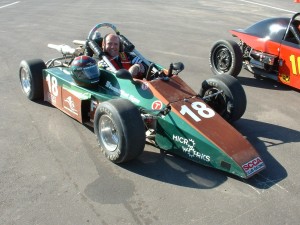
A few weeks ago I pulled the F500 out of the garage after getting it running from it’s long hibernation being on display over at F1 Race Factory. So I push the car into the street. Climb in, strap the car on (you wear a Formula Car) and fire it up to make sure it’s working by taking it into and around our cul-de-sac. FYI: the transmission of an F500 is setup so that it will not even engage the clutch until you hit 5000 RPM – just to move the car under it’s own power from point A to point B is like a drag racing hole shot.)
Step on the throttle and watch/listen to the RPM climb up from an idle of about 1,500. Finally, as the revs hit 5,000 and the car realizes that I’m serious about wanting it to move it launches itself.
Because the street was cold as were the rear tires I immediately had to feed in an armful of steering to keep the car pointed down the street since the rear end is stepping out propelling me down the street sideways.  When the spinning rear wheels finally “start” to get some heat and hook up the speed increases as I straighten the wheel just as I need to turn hard right to navigate into the cul-de-sac. Of course the front tires have no heat in them so the car just pushes/understeers/plows straight ahead. I had wanted to go round the cul-de-sac toward the left. Ended up having to go round toward the right since the front end didn’t bite until I was well past the entry to the cul-de-sac…
Enjoy Clarkson’s article…
Cool Car…
Not often that someone actually brings a SuperCar out to do an HPDE1 event. Yesterday (5-2-09) was one of those times. The husband had done the school in this car – Ferrari F430 (he is now driving an M3 in one of the race groups) and he had his wife take the class with the car too.
I actually like instructing females in the class. Unlike the guys they don’t tend to allow their egos to get in the way and think they can drive fast. Rather they work on their technique and as they get comfortable and their confidence incresaes so does their speed.
In the first track session we only got as fast as 55 in the oval and about 80 down the front straight. In the second session she got her speed up to 80 (while passing another car) in the oval and hit 100 down the front straight. She had fun and the car was quick and the sound of the exhaust was awesome.
[media id=15 width=320 height=240]
Top Gear evaluates the F430 Coupe and Spyder
Typical Weekend w/ NASA
About once a month I instruct High Performance Driving for the Arizona Region of the National Auto Sport Association (NASA). This is what a typical day at the track is like…
After signing up for the class (and getting a NASA membership) you show up to the track we are running at (PIR, Firebird, etc) around 6-7am. Take your car through tech inspection (checking battery tie down, tires, etc…) and then attend the morning drivers meeting at about 7:45am. The “Driver’s Meeting” is where the day’s schedule will be discussed and any important information relayed. Then that meeting will break up to allow the smaller individual groups (HPDE1, HPDE2, HPDE3, HPDE4, Time Trials, Race, etc…) to meet with their group leaders. At this time I’ll take the HPDE1 students to the classroom for their first session.
In the first class we go over track etiquette, flags, how to sit in the car, adjust mirrors, etc… and go over track photos and a track video. Basic info to keep you safe on track. This classroom session is normally around 1 hour 15 minutes.
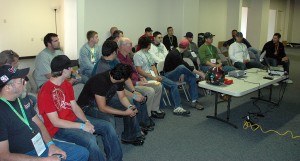
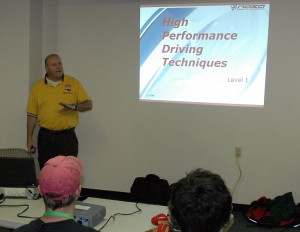
The student then will go on track for the first of three 30-minute sessions.  The in-car instructor will drive the students car for the first 10-minutes of this first session. He will not be driving it fast. Figure if flat out driving is 10/10ths the instructor will drive at about 4/10ths. The idea is so that he can feel what your brakes, suspension, etc… feels like as well as point out the references points and track features that were discussed in class. Then they pull into the Hot Pits and swap drivers so that the student will drive for the final 20-minutes of that session.
Back to Class for the second classroom session where we go over apexes, vehicle dynamics etc… and discuss things that happened on track in the first session.
Back on track for another 30-minute track session with the student at the wheel for the entire time.
Back to the Classroom for a debriefing session and to get their logbook that the in-car instructor will fill out and sign after the third (and final) 30-minute track session.
NASA has four levels for street cars. Level 1 is the beginner class. Passing only on the main straight and preferably with a point by from the car being passed.
Level 2 is the next rung. Just like in Level 1 there are limited passing zones but the speeds can be significantly faster.
Level 3 has passing anywhere on track.
Level 4 is the only DE group with laps being timed. The drivers in DE4 are competing against the clock. It’s called a Time Trial but figure it being like an Auto Cross on a road course with multiple cars on the track at the same time.
Graduating the DE1 class with a signed off logbook moves you into DE2. To move from DE2 to DE3 you ask the DE2 Group Leader if you can move up and if he thinks you are ready he or one of his assistants will give you a check ride. You then present yourself to the DE3 Group Leader and either he or one of his assistants will give you another check ride to determine whether they will accept you into their group. This keeps drivers from moving up that should not and also allows the Group Leaders to demote a driver to the lower group if they need to work on skills.
Besides the four DE groups there are also 2-3 race groups (grouped by horse power) as well as the occasional drift group that comes out a few times a year.
—————-
The DE1 class is a High Performance Driving Class. It is not a racing school. Different concepts and theory. What is taught in the DE1 class will certainly help you be a better and more aware driver on the street. As for the equipment you need for the class.
Helmet. Yep. It does not have to be a SNELL rated fire proof racing helmet. It can be a regular DOT motorcycle class helmet. Full face or open Face. But not one of those “Shortie” helmets you see some wanna be Hog riders or Vespa/moped (hehe…) riders wear.
No need for a drivers suit. Jeans and a long sleeve shirt are fine. No open toed shoes. Tennis Shoes or a nice flat bottomed “driving” loafer. As long as they are comfortable and not bulky. You want to be able to feel the throttle and brake pedals.
Gloves? Required no. However, I would recommend them for grip purposes but they don’t need to be fireproof racing gloves. You could wear some old British Car correct string-back gloves.
Seatbelt. Yes. Racing harness? No. I’m not sure on tech but I would expect that a simple lap belt would not be sufficient. At least a typical three point belt (across the lap and over one shoulder) like that found in most cars is all that is required.
Rollbar? Has not been required. Typically, they would probably ask that you put up the top on a convertible.
My oldest Daughter took the class last year on her 17th Birthday. She drove her automatic transmission BMW 528e for the class. Typically the students in the class are male (although we generally have 1-2 females per class*) and are driving their street car. BMW, Honda, Mazda, Vette, etc… But I have had a student in a Pickup truck and even had a lady take the class in her Nissan Xterra SUV. Last month I had students in a brand new Ford GT (belching 2 feet of flame when the driver lifted off the gas for turn 1) and a Ferrari 360 Spyder. They were sharing the track with other DE1 students in an old Datsun 240Z and a Subaru WRX. Tremendous mix of cars. No speed limit but restricted passing zones. Typical class will have about 18 students.
* I prefer to be the in-car instructor for the female students myself as they don’t tend to bring too much ego to the car and “think” they already know how to drive. They are willing to listen and therefore make progress across the day without lots of bad habits to try and break.
Fixing a Flat…
Prety cool trick. One reason to keep a lighter and some flammable spray in your tool kit. Of course a tire working itself off the rim is not going to be your typical reason for a flat tire.
[media id=8 width=320 height=240]
TR Club Trip to Arcosanti
Nice fall weather, dirt roads and sportscars and a day out with your spouse! Can it get any better?
Firebird Race Report – Part Deux
Originally posted on 10/11/2001
—————-
Due to Popular demand (well ok just two people emailed to say they liked it) I am submitting the second part of this report.
——————–
Sunday, Oct 7th
Firebird Raceway, Phoenix, AZ
San Diego Double Regional
After the problems seen on Saturday getting the car running in time for the race it was a real relief that we did not experience any similar problems on Sunday morning. Since the FF/CF/F500/FV group was still in the #5 position we had time to walk around the paddock and admire some of the other cars that were there in the incredibly gorgeous weather we had that morning. There was one Club Ford in particular that was quite pleasing to the eye. The owner had made new custom body work for it (this was also his first attempt at laying up fiberglass) and he had painted it in Ferrari Red and it even had what looked like Ferrari decals on it, that is until you looked close and saw that the silhouette of the prancing horse had been replaced with a silhouette of his Black Lab!
Practice…
For the practice session the car behaved very well and seemed to have shed any of the problems that were seen on the previous day’s outing.
Firebird Race Report Part 1
Originally posted on 10/7/2001
——————–
For those that have complained about a lack of race reports I present the following (Being posted to both the F500 list and on the Wheel:
————————–
Since this is a Double Regional for the San Diego Region this weekend here in Phoenix at Firebird I will send two reports.
Prelude…
I had taken my car in to have the motor repaired (we thought we had experienced a lean burn again) but when the motor was taken apart it was discovered that a rod had broken. Of course all the parts I had gotten for a top end rebuild were only going to be part of the solution. Chuck Voboril had two spare Kawi motors and sold one to me so that we could get the car back together and running while I get the other motor fixed. We worked until late Friday getting the motor in and running (had a CDI fail) so the first practice on Saturday would be the first test of this motor (other than a couple quick bursts up and down the street before the car went on the trailer)
Saturday…Practice
The morning dawned a typical gorgeous early fall day here in Phoenix with the temperature just right and I could not wait to get on track and see how the car would run. Driving from the Paddock to Grid for practice was a real joy as the motor felt really strong and the acceleration snapped my head back against the head rest when the clutch engaged at 5k RPM.
Pulling onto track behind a LeGrand CF (the last one ever made) I quickly made short work of him and set my sites on reeling in another CF and then trying to keep up with the FF when it all came to naught! On the third lap a Swift DB-1 FF had gone into the wall in the “Valley of Death” and brought at the Black Flag. While sitting in the Pits waiting for the mess to be cleaned up we were told they had stopped the clock and would get at least seven more minutes of practice time. This turned out not to be the case however as just as were starting our cars they waved the Checker to end our sessions with just three laps having been run! As I stepped on the gas to head back to the Paddock I could not get the motor above 3500 RPM. Since the clutch does not engage below 5k this presented a bit of a problem and required a ignominious flat tow back to my Paddock. Since the motor would start and run (albeit weakly) I figured it must be a fuel starvation problem. Fuel Filter and fuel pump checked out ok so after checking the spark plugs I decided to check the fuel cell in case the pickup was not clogged. Rolled up my sleeve and dug out the foam and did not see a problem there either. Put the car back together and thought for grins lets try it. Fired it up and like magic the motor screamed to life when the throttle was opened. We thought it must have just been “one of those things”, so we sat down to talk to our guests that had come out to watch the races.
Race Report 2/24/01
This weekend I took my T-83 Red Devil F500 out to Firebird for a NASA event (I treat these days as a test and tune session since we generally do not have that many cars that show up to run in the Open Wheel group).
I had just finished installing a new dash and a MY-CHRON Pro system and wanted to get it broke in for the SCCA Regional this coming weekend at PIR, the MY-CHRON worked fine it was my car that broke.
The field was made up of my F500, a Lola CF, two SRF a FM and a beast of a Lola (model ?? picture of it here –
http://www.nasa-az.com/PICS.html). A friend was supposed to bring his Ralt RT-5 FA out to run but a death in the family kept him seeing to more important matters. A couple other CFs were supposed to come also, but the trailer did not get here from out of state in time.
The forecast for the day had originally called for rain, but the moring came with a cloudless sky and temps in the 60’s. A beautiful day for racing!
